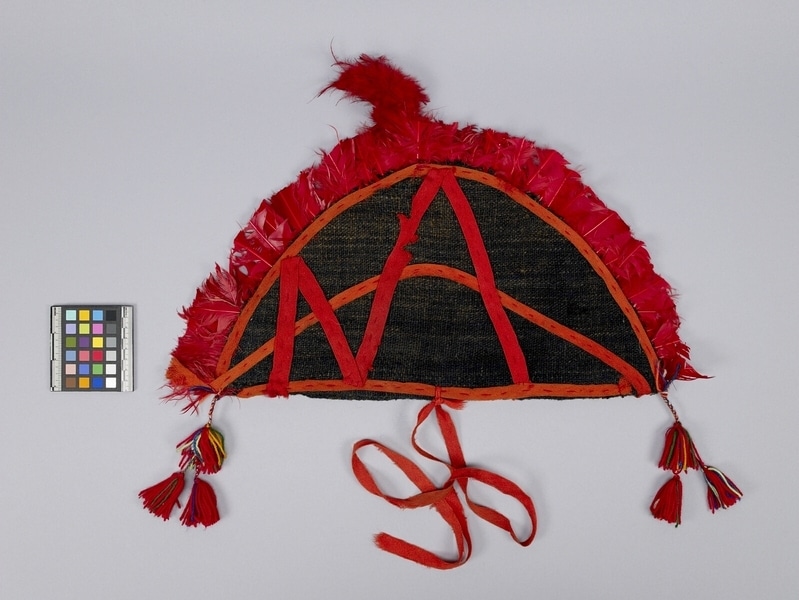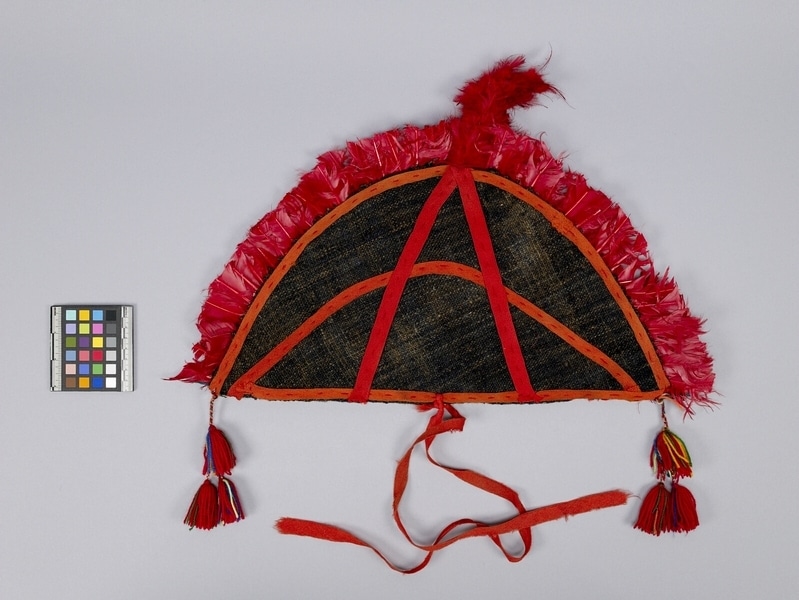Coxcomb Dancing Hat Item Number: Sf1014 from the MOA: University of British Columbia


Description
A semi-circular hat composed of two similar pieces stitched together along the curved edge. Red feathers with the points cut off are inserted between the semi-circles of dark blue bayeta. An orange, braided tape is appliqued to both sides and attached as chin ties to the centre of each side. Three red, blue, green, and orange yarn tassels are attached by braided cords to each end of the semi-circular hat.
History Of Use
Bayeta, a type of coarse cloth, is made on the treadle loom and is used for garments that are cut to size and sewn, such as trousers, shirts and vests. The style, the construction and the loom used are derived from Spanish peasant tradition. Handspun sheep's wool is the traditional material but synthetic yarns are now used as well. The hat is worn straight with the tassel and feathers in line with the nose. White trousers and knee high black leggings are worn with a black poncho and several coca bags. A dance sling and a white flag are used as well. The Dance of the Negritos, or 'Dandies', is performed at the Festival of Candelaria. Female dancers accompany the Negrito dancers.
Narrative
Made by the father of the seller and used by him. The seller has used it since 1979, most recently in 1985. It has also been loaned out extensively as is the practice with specialized costume pieces in Taquile. Juan's grandfather, Marcelino Flores Huatta, also had a hat like this which served as a model for the present one.
Iconographic Meaning
The dance is performed in a cocky manner with movements that imitate those of roosters; a ducking head motion and scratching in the earth with the feet. The lengthwise band of red feathers represent the coxcomb of the rooster.
Cultural Context
Fiestas
Item History
- Made by Andres Flores C'Care (Maker) in Taquile, Puno, Peru between 1945 and 1955
- Collected by Mary Frame during 1987
- Owned by Juan Flores Machaca
- Owned by Mary Frame before November 3, 1987
- Received from Mary Frame (Seller) and Museum of Anthropology Shop Volunteers (Funding source) on November 3, 1987
What
- Name
- Coxcomb Dancing Hat
- Identification Number
- Sf1014
- Type of Item
- hat
- Material
- wool fibre, feather, synthetic fibre and skin
- Manufacturing Technique
- woven, sewn and braided
- Overall
- height 33.0 cm, width 52.0 cm, depth 5.0 cm
Who
- Culture
- Quechua
- Creator
- Andres Flores C'Care (Maker)
- Field Collector
- Mary Frame
- Previous Owner
- Juan Flores Machaca and Mary Frame
- Received from
- Mary Frame (Seller) and Museum of Anthropology Shop Volunteers (Funding source)
Where
- Holding Institution
- MOA: University of British Columbia
- Made in
- Taquile, Puno, Peru
When
- Creation Date
- between 1945 and 1955
- Collection Date
- during 1987
- Ownership Date
- before November 3, 1987
- Acquisition Date
- on November 3, 1987
Other
- Item Classes
- textiles
- Condition
- fair
- Accession Number
- 1274/0019